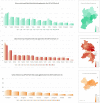Analysis of the Spatiotemporal Evolution of the Net Carbon Sink Efficiency and Its Influencing Factors at the City Level in Three Major Urban Agglomerations in China
- PMID: 36673923
- PMCID: PMC9859557
- DOI: 10.3390/ijerph20021166
Analysis of the Spatiotemporal Evolution of the Net Carbon Sink Efficiency and Its Influencing Factors at the City Level in Three Major Urban Agglomerations in China
Abstract
The implementation of carbon peaking and carbon neutrality is an essential measure to reduce greenhouse gas emissions and actively respond to climate change. The net carbon sink efficiency (NCSE), as an effective tool to measure the carbon budget capacity, is important in guiding the carbon emission reduction among cities and the maintenance of sustainable economic development. In this paper, NCSE values are used as a measure of the carbon budget capacity to measure the spatiotemporal evolution of the carbon neutral capacity of three major urban agglomerations (UAs) in China during 2007-2019. The clustering characteristics of the NCSE of these three major UAs, and various influencing factors such as carbon emissions, are analyzed using a spatiotemporal cube model and spatial and temporal series clustering. The results reveal the following. (1) From the overall perspective, the carbon emissions of the three major UAs mostly exhibited a fluctuating increasing trend and a general deficit during the study period. Moreover, the carbon sequestration showed a slightly decreasing trend, but not much fluctuation in general. (2) From the perspective of UAs, the cities in the Beijing-Tianjin-Hebei UA are dominated by low-low clustering in space and time; this clustering pattern is mainly concentrated in Beijing, Xingtai, Handan, and Langfang. The NCSE values in the Yangtze River Delta UA centered on Shanghai, Nanjing, and the surrounding cities exhibited high-high clustering in 2019, while Changzhou, Ningbo, and the surrounding cities exhibited low-high clustering. The NCSE values of the remaining cities in the Pearl River Delta UA, namely Guangzhou, Shenzhen, and Zhuhai, exhibited multi-cluster patterns that were not spatially and temporally significant, and the spatiotemporal clusters were found to be scattered. (3) In terms of the influencing factors, the NCSE of the Beijing-Tianjin-Hebei UA was found to be significantly influenced by the industrial structure and GDP per capita, that of the Yangtze River Delta UA was found to be significantly influenced by the industrial structure, and that of the Pearl River Delta UA was found to be significantly influenced by the population density and technology level. These findings can provide a reference and suggestions for the governments of different UAs to formulate differentiated carbon-neutral policies.
Keywords: NCSE; carbon budget; influencing factors; urban agglomerations.
Conflict of interest statement
The authors declare no conflict of interest.
Figures





Similar articles
-
Regional differences, dynamic evolution, and spatial spillover effects of carbon emission intensity in urban agglomerations.Environ Sci Pollut Res Int. 2023 Dec;30(58):121993-122010. doi: 10.1007/s11356-023-30807-y. Epub 2023 Nov 14. Environ Sci Pollut Res Int. 2023. PMID: 37957497
-
Spatial Differences and Influential Factors of Urban Carbon Emissions in China under the Target of Carbon Neutrality.Int J Environ Res Public Health. 2022 May 25;19(11):6427. doi: 10.3390/ijerph19116427. Int J Environ Res Public Health. 2022. PMID: 35682024 Free PMC article.
-
[Spatialization and Spatio-temporal Dynamics of Energy Consumption Carbon Emissions in China].Huan Jing Ke Xue. 2022 Nov 8;43(11):5305-5314. doi: 10.13227/j.hjkx.202112066. Huan Jing Ke Xue. 2022. PMID: 36437102 Chinese.
-
A review of applied research on low-carbon urban design: based on scientific knowledge mapping.Environ Sci Pollut Res Int. 2023 Oct;30(47):103513-103533. doi: 10.1007/s11356-023-29490-w. Epub 2023 Sep 14. Environ Sci Pollut Res Int. 2023. PMID: 37704820 Review.
-
Exploration of the Implementation of Carbon Neutralization in the Field of Natural Resources under the Background of Sustainable Development-An Overview.Int J Environ Res Public Health. 2022 Oct 28;19(21):14109. doi: 10.3390/ijerph192114109. Int J Environ Res Public Health. 2022. PMID: 36360986 Free PMC article. Review.
References
-
- IEA Financing Clean Energy Transitions in Emerging and Developing Economies. 2021. [(accessed on 5 October 2022)]. Available online: https://www.iea.org/reports/financingcleanenergytransitionsinemergingand....
-
- Hasegawa T., Fujimori S., Frank S., Humpenöder F., Bertram C., Després J., Drouet L., Emmerling J., Gusti M., Harmsen M., et al. Land-based implications of early climate actions without global net-negative emissions. Nat. Sustain. 2021;4:1052–1059. doi: 10.1038/s41893-021-00772-w. - DOI
-
- Vaccari F.P., Gioli B., Toscano P., Perrone C. Carbon dioxide balance assessment of the city of Florence (Italy), and implications for urban planning. Landsc. Urban Plan. 2013;120:138–146. doi: 10.1016/j.landurbplan.2013.08.004. - DOI
-
- Lin B., Ge J. Valued forest carbon sinks: How much emissions abatement costs could be reduced in China. J. Clean. Prod. 2019;224:455–464. doi: 10.1016/j.jclepro.2019.03.221. - DOI
-
- IPCC AR5 Climate Change 2014: Impacts, Adaptation, and Vulnerability. 2014. [(accessed on 5 October 2022)]. Available online: https://www.ipcc.ch/report/ar5/wg2/
Publication types
MeSH terms
Substances
Associated data
LinkOut - more resources
Full Text Sources

